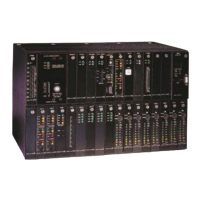Chapter 5. Diagnostics
165
In drop-and-insert mode, the bypass relay passes T1 around the multiplexer without going through the
primary multiplex circuitry. With Dual DSX-1 Interfaces, the signal passes only through line equalization.
With the Dual CSU Interface, the repeaters and line equalization build-out are in the bypass path.
Bypass also loops the PCM signal from the LIUs. The local alarm disappears when the LIUs have
synchronized to the loop condition (approximately 10 seconds). If the local alarms do not clear, there
may be a problem with the LIUs. The multiplexer remains in CGA during bypass operation.
In dual channel bank mode, bypass mode is not possible and the bypass switch is disabled.
Power-Up Sequence
The normal power-up sequence returns the system to the same operation status as before the power
cycle. Upon initial power-up, the multiplexer defaults to LIU A and Strobe Unit option switches. After
Non-Volatile Random Access Memory (NVRAM) has been selected through the Set shelf Configuration
(SC) command, the power-up options default to NVRAM selections.
The front panel switches double as special power-up controls. The switches can be used to clear the
system memory (NVRAM) and auto-configure. During an auto-configuration sequence the default data
rate of the COM port is 1200 bps. Adjust the control terminal data rate accordingly.
Depressing the ACO button during power-up activates an option switch power-up. The system auto-
configures from the LIU A, Strobe, and line card option switches. A matrix map is constructed from the
line card switch options, and is placed in the Map 1 location. Map 1 is then made the (new) working
map. Line cards are given bandwidth on a first-come-first-served basis, starting with card slot one. If a
line card requests bandwidth that is not available, none is assigned. The Option Switch Power-up does
not alter configuration on maps 2 through 7.
Note: Depressing the BYP (Bypass) button during power-up causes the CCU/MCU to “bypass” the checksum test.
Depressing both the ACP and BYP buttons for 75 seconds activates a CCU/MCU NVRAM power-up on
a shelf that has been powered down. The system operates the same as in an Option Switch Power-up,
and all of the system map matrices are cleared. The NVRAM power-up clears all CCU/MCU memory,
including passwords, and switches all options to default. An NVRAM power-up should be used only for
drastic failure situations, or when placing the system in a new location and application.
CAUTION!
NVRAM power-up clears all shelf, line card, and password information.
Troubleshooting
When a fault is apparent within the D/I Mux III system, board-level troubleshooting procedures further
isolate the problem. When the fault is isolated to one or more unit assemblies, replace each suspected
unit with a known good spare until the fault clears. When replacement of a unit does not clear the fault,
remove the spare and reinstall the original unit. Spare units should be stocked for this purpose. Refer to
Table 5-2 for information on interpreting LEDs.

